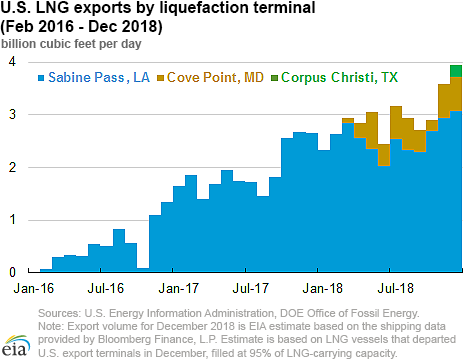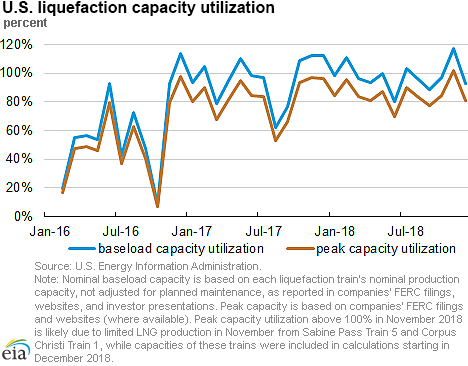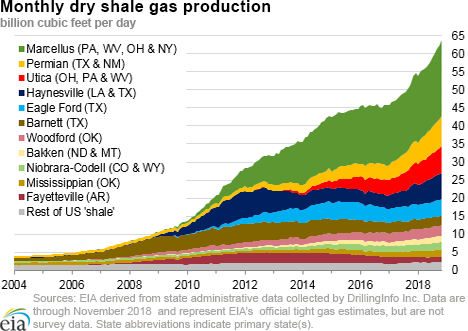In the News:
U.S. LNG exports increase this winter, as two new trains are placed in service
U.S. liquefied natural gas (LNG) exports set two consecutive monthly records in November and December 2018, with 32 and 36 exported cargoes, respectively. Two new liquefaction trains—Sabine Pass Train 5 and Corpus Christi Train 1—began LNG production in late November. EIA estimates that U.S. LNG exports averaged 3.6 billion cubic feet per day (Bcf/d) in November and 3.9 Bcf/d in December, based on the vessel shipping data provided by Bloomberg Finance, L.P.
The United States began exporting LNG from the Lower 48 states in February 2016, when the Sabine Pass liquefaction terminal in Louisiana shipped its first cargo. Since then, Sabine Pass expanded from one to five operating liquefaction trains, Cove Point LNG export facility began operation in Maryland, and Corpus Christi Train 1 began LNG production several months ahead of schedule and shipped its first cargo in December. U.S. LNG exports are poised to increase further as more export facilities come online in 2019–21.
Existing U.S. LNG nominal baseload liquefaction capacity is estimated at 4.25 Bcf/d and peak capacity at 4.87 Bcf/d across seven trains at three liquefaction terminals. Once the remaining facilities under construction—Elba Island, Cameron, and Freeport—and the remaining two trains at Corpus Christi are placed in service, EIA estimates that U.S. nominal baseload liquefaction capacity will stand at 9.6 Bcf/d (72.3 million metric tons per annum (mtpa)) and peak capacity at 10.7 Bcf/d (80.9 mtpa). Once all trains are fully ramped up post-2020, U.S. liquefaction facilities will likely operate at peak nominal capacities during periods of peak demand, particularly in winter and summer months.
EIA estimates that Sabine Pass facility has been running above 100% of its nominal baseload liquefaction capacity in the winter months and near 100% of its baseload capacity in the summer months once the new trains at the facility have been fully ramped up. Utilization of the facility in the winter 2017–18 is estimated at 107% of the nominal baseload and 92% of peak capacity; in the summer 2018—at 97% and 83%, respectively. Annual 2018 utilization at Sabine Pass is estimated at 106% of the baseload and 91% of peak capacity. Cove Point terminal has also run above 90% of its baseload capacity in November–December 2018, with an overall utilization of 67% of baseload and 62% of peak capacity since the facility started operation in March 2018.
Because commissioning of the new facilities is done gradually over a period of several months, EIA forecasts U.S. LNG exports to increase gradually in 2019 and average 5.1 Bcf/d on an annual basis, up from 3.0 Bcf/d annual average in 2018. In 2020, however, as the new trains ramp up LNG production, U.S. LNG exports are projected to increase and average 6.8 Bcf/d annually, with higher exports in the winter and summer seasons and lower exports in the spring and fall months.
The latest information on the status of U.S. liquefaction facilities, including expected online dates and capacities, is available in EIA's database of U.S. LNG export facilities.
Overview:
(For the Week Ending Wednesday, January 16, 2019)
- Natural gas spot prices rose at most locations this report week (Wednesday, January 9 to Wednesday, January 16). Henry Hub spot prices rose from $2.91 per million British thermal units (MMBtu) last Wednesday to $3.61/MMBtu yesterday.
- At the Nymex, the price of the February 2019 contract increased 40¢, from $2.984/MMBtu last Wednesday to $3.384/MMBtu yesterday. The price of the 12-month strip averaging February 2019 through January 2020 futures contracts climbed 12¢/MMBtu to $2.965/MMBtu.
- Net withdrawals from working gas totaled 81 billion cubic feet (Bcf) for the week ending January 11. Working natural gas stocks are 2,533 Bcf, which is 3% lower than the year-ago level and 11% lower than the five-year (2014–18) average for this week.
- The natural gas plant liquids composite price at Mont Belvieu, Texas, rose by 26¢/MMBtu, averaging $6.46/MMBtu for the week ending January 16. The price of natural gasoline, ethane, propane, butane, and isobutane all rose, by 5%, 1%, 7%, 3%, and 1%, respectively.
- According to Baker Hughes, for the week ending Tuesday, January 8, the natural gas rig count increased by 4 to 202. The number of oil-directed rigs fell by 4 to 873. The total rig count remains unchanged at 1,075.
Prices/Supply/Demand:
Prices rise across most of the Lower 48 states. This report week (Wednesday, January 9 to Wednesday, January 16), Henry Hub spot prices rose 70¢ from $2.91/MMBtu last Wednesday to their weekly high of $3.61/MMBtu yesterday. At the Chicago Citygate, prices increased 82¢ from $2.70/MMBtu last Wednesday to $3.52/MMBtu yesterday. Temperatures remained cold for most of the report week, and the return of winter weather, especially on the East Coast, put upward pressure on prices.
Northeast prices mostly rise. Below-freezing temperatures across most of the Northeast led to higher prices. At the Algonquin Citygate, which serves Boston-area consumers, prices went up $4.78 from $6.60/MMBtu last Wednesday to their weekly high of $11.38/MMBtu yesterday.
Prices at the Transcontinental Pipeline Zone 6 trading point in New York City rose by $2.13 from $3.12/MMBtu last Tuesday to $5.25/MMBtu last Wednesday, in anticipation of colder temperatures. Since then, prices gradually dropped to $4.04/MMBtu yesterday.
Tennessee Zone 4 Marcellus spot prices increased 72¢ from $2.71/MMBtu last Wednesday to $3.43/MMBtu yesterday. Prices at Dominion South in southwest Pennsylvania rose 77¢ from $2.65/MMBtu last Wednesday to $4.42/MMBtu yesterday.
Prices rise in California. Prices at PG&E Citygate in Northern California rose $1.20 from $3.42/MMBtu last Wednesday to $4.62/MMBtu yesterday. Prices at SoCal Citygate increased 71¢ from $4.66/MMBtu last Wednesday to $5.37/MMBtu yesterday. Higher prices were largely driven by cooler temperatures during the report week, particularly in Southern California, leading to withdrawals from storage.
Discount at Permian Basin trading hub persists. Prices at the Waha Hub in West Texas, which is located near Permian Basin production activities, averaged $2.06/MMBtu last Wednesday, 85¢/MMBtu lower than Henry Hub prices. Yesterday, prices at the Waha Hub averaged $2.29/MMBtu, $1.32/MMBtu lower than Henry Hub prices.
Supply rises as dry natural gas production continues to grow. According to data from PointLogic Energy, the average total supply of natural gas rose by 1% to 94.4 Bcf/d compared with the previous report week. Dry natural gas production grew by 1% to 88 Bcf/d compared with the previous report week. Average net imports from Canada increased by 5% from last week as U.S. imports from Canada increased while U.S. exports to Canada declined.
Demand rises amid cooler temperatures. Total U.S. consumption of natural gas rose by 18% compared with the previous report week, according to data from PointLogic Energy, averaging 97.2 Bcf/d. Natural gas consumed for power generation rose 14%. Industrial sector consumption increased 5% week over week. In the residential and commercial sectors, consumption increased 30%, averaging 46.9 Bcf/d during the report week as winter weather swept through most of the Lower 48 states. Natural gas exports to Mexico declined 1% week over week, averaging 4.7 Bcf/d for the report week.
U.S. LNG exports decrease week over week. Eight LNG vessels (six from Sabine Pass, one from Cove Point, and one from Corpus Christi) with a combined LNG-carrying capacity of 28.4 Bcf departed the United States between January 10 and January 16, and two vessels were loading on Wednesday―one at Sabine Pass and one at Cove Point—according to shipping data compiled by Bloomberg.
Storage:
Net withdrawals from storage totaled 81 Bcf for the week ending January 11, compared with the five-year (2014–18) average net withdrawals of 218 Bcf and last year's net withdrawals of 208 Bcf during the same week. Working gas stocks totaled 2,533 Bcf, which is 327 Bcf lower than the five-year average and 77 Bcf lower than last year at this time.
According to The Desk survey of natural gas analysts, estimates of the weekly net change from working natural gas stocks ranged from net injections of 55 Bcf to 92 Bcf, with a median estimate of 82 Bcf.
The average rate of net withdrawals from storage is 31% lower than the five-year average so far in the withdrawal season (November through March). If the rate of withdrawals from storage matched the five-year average of 15.5 Bcf/d for the remainder of the withdrawal season, total inventories would be 1,309 Bcf on March 31, which is 327 Bcf lower than the five-year average of 1,636 Bcf for that time of year.
More storage data and analysis can be found on the Natural Gas Storage Dashboard and the Weekly Natural Gas Storage Report.
See also:
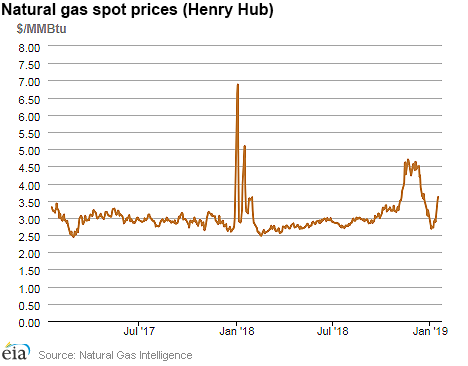
| Spot Prices ($/MMBtu) | Thu, 10-Jan |
Fri, 11-Jan |
Mon, 14-Jan |
Tue, 15-Jan |
Wed, 16-Jan |
|---|---|---|---|---|---|
| Henry Hub |
2.95 |
2.88 |
3.36 |
3.52 |
3.61 |
| New York |
4.99 |
3.85 |
3.98 |
3.78 |
4.04 |
| Chicago |
2.71 |
2.72 |
3.28 |
3.45 |
3.52 |
| Cal. Comp. Avg.* |
3.12 |
3.15 |
3.88 |
4.28 |
4.43 |
| Futures ($/MMBtu) | |||||
| February contract | 2.969 |
3.099 |
3.591 |
3.501 |
3.384 |
| March contract |
2.813 |
2.945 |
3.289 |
3.249 |
3.147 |
| *Avg. of NGI's reported prices for: Malin, PG&E Citygate, and Southern California Border Avg. | |||||
| Sources: Natural Gas Intelligence and CME Group as compiled by Bloomberg, L.P. | |||||
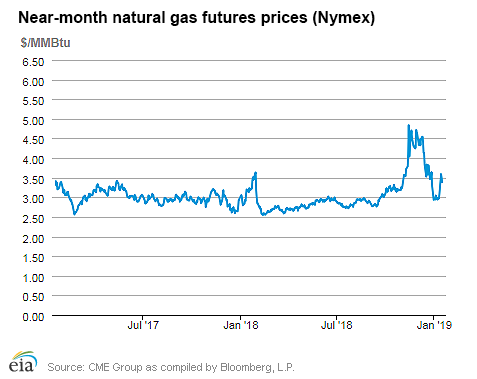
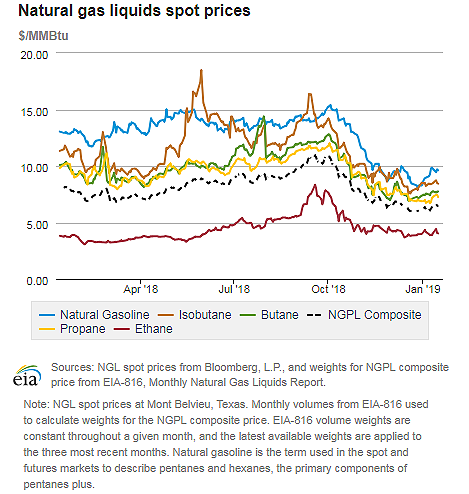
| U.S. natural gas supply - Gas Week: (1/10/19 - 1/16/19) | |||
|---|---|---|---|
Average daily values (Bcf/d): |
|||
this week |
last week |
last year |
|
| Marketed production | 98.4 |
97.7 |
86.1 |
| Dry production | 88.0 |
87.4 |
76.9 |
| Net Canada imports | 6.0 |
5.7 |
6.0 |
| LNG pipeline deliveries | 0.4 |
0.2 |
0.3 |
| Total supply | 94.4 |
93.4 |
83.3 |
|
Source: OPIS PointLogic Energy, an IHS Company | |||
| U.S. natural gas consumption - Gas Week: (1/10/19 - 1/16/19) | |||
|---|---|---|---|
Average daily values (Bcf/d): |
|||
this week |
last week |
last year |
|
| U.S. consumption | 97.2 |
82.3 |
94.4 |
| Power | 25.3 |
22.3 |
25.3 |
| Industrial | 25.0 |
23.9 |
24.8 |
| Residential/commercial | 46.9 |
36.2 |
44.3 |
| Mexico exports | 4.7 |
4.7 |
4.4 |
| Pipeline fuel use/losses | 7.6 |
6.4 |
7.4 |
| LNG pipeline receipts | 4.8 |
5.0 |
2.6 |
| Total demand | 114.4 |
98.5 |
108.8 |
|
Source: OPIS PointLogic Energy, an IHS Company | |||
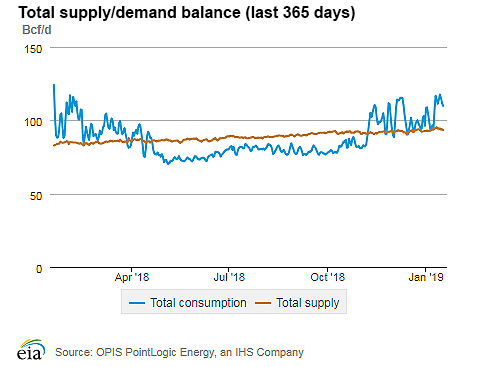
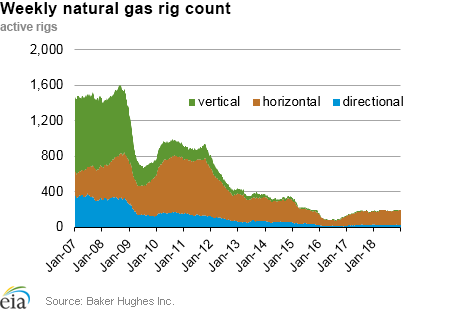
| Rigs | |||
|---|---|---|---|
Tue, January 08, 2019 |
Change from |
||
last week |
last year |
||
| Oil rigs | 873 |
-0.5% |
16.1% |
| Natural gas rigs | 202 |
2.0% |
8.0% |
| Note: Excludes any miscellaneous rigs | |||
| Rig numbers by type | |||
|---|---|---|---|
Tue, January 08, 2019 |
Change from |
||
last week |
last year |
||
| Vertical | 65 |
1.6% |
4.8% |
| Horizontal | 948 |
0.3% |
17.8% |
| Directional | 62 |
-6.1% |
-13.9% |
| Source: Baker Hughes Inc. | |||
| Working gas in underground storage | ||||
|---|---|---|---|---|
Stocks billion cubic feet (Bcf) |
||||
| Region | 2019-01-11 |
2019-01-04 |
change |
|
| East | 620 |
651 |
-31 |
|
| Midwest | 729 |
763 |
-34 |
|
| Mountain | 127 |
132 |
-5 |
|
| Pacific | 196 |
204 |
-8 |
|
| South Central | 861 |
865 |
-4 |
|
| Total | 2,533 |
2,614 |
-81 |
|
| Source: Form EIA-912, "Weekly Underground Natural Gas Storage Report" | ||||
| Working gas in underground storage | |||||
|---|---|---|---|---|---|
Historical comparisons |
|||||
Year ago (1/11/18) |
5-year average (2014-2018) |
||||
| Region | Stocks (Bcf) |
% change |
Stocks (Bcf) |
% change |
|
| East | 621 |
-0.2 |
666 |
-6.9 |
|
| Midwest | 726 |
0.4 |
769 |
-5.2 |
|
| Mountain | 159 |
-20.1 |
164 |
-22.6 |
|
| Pacific | 245 |
-20.0 |
264 |
-25.8 |
|
| South Central | 859 |
0.2 |
997 |
-13.6 |
|
| Total | 2,610 |
-3.0 |
2,860 |
-11.4 |
|
| Source: Form EIA-912, "Weekly Underground Natural Gas Storage Report" | |||||
| Temperature – heating & cooling degree days (week ending Jan 10) | ||||||||
|---|---|---|---|---|---|---|---|---|
HDD deviation from: |
CDD deviation from: |
|||||||
| Region | HDD Current |
normal |
last year |
CDD Current |
normal |
last year |
||
| New England | 220 |
-51 |
-113 |
0 |
0 |
0 |
||
| Middle Atlantic | 207 |
-52 |
-125 |
0 |
0 |
0 |
||
| E N Central | 207 |
-86 |
-121 |
0 |
0 |
0 |
||
| W N Central | 215 |
-102 |
-90 |
0 |
0 |
0 |
||
| South Atlantic | 122 |
-60 |
-125 |
7 |
-1 |
3 |
||
| E S Central | 119 |
-70 |
-104 |
0 |
-2 |
0 |
||
| W S Central | 87 |
-54 |
-39 |
2 |
-1 |
2 |
||
| Mountain | 200 |
-37 |
31 |
0 |
0 |
0 |
||
| Pacific | 116 |
-9 |
35 |
0 |
0 |
0 |
||
| United States | 167 |
-58 |
-72 |
2 |
0 |
1 |
||
|
Note: HDD = heating degree day; CDD = cooling degree day Source: National Oceanic and Atmospheric Administration | ||||||||
Average temperature (°F)
7-Day Mean ending Jan 10, 2019
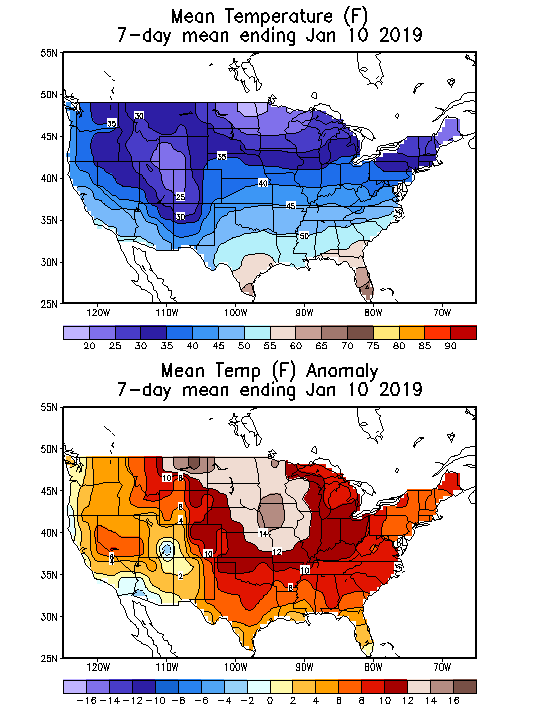
Source: NOAA National Weather Service
Deviation between average and normal (°F)
7-Day Mean ending Jan 10, 2019

Source: NOAA National Weather Service

